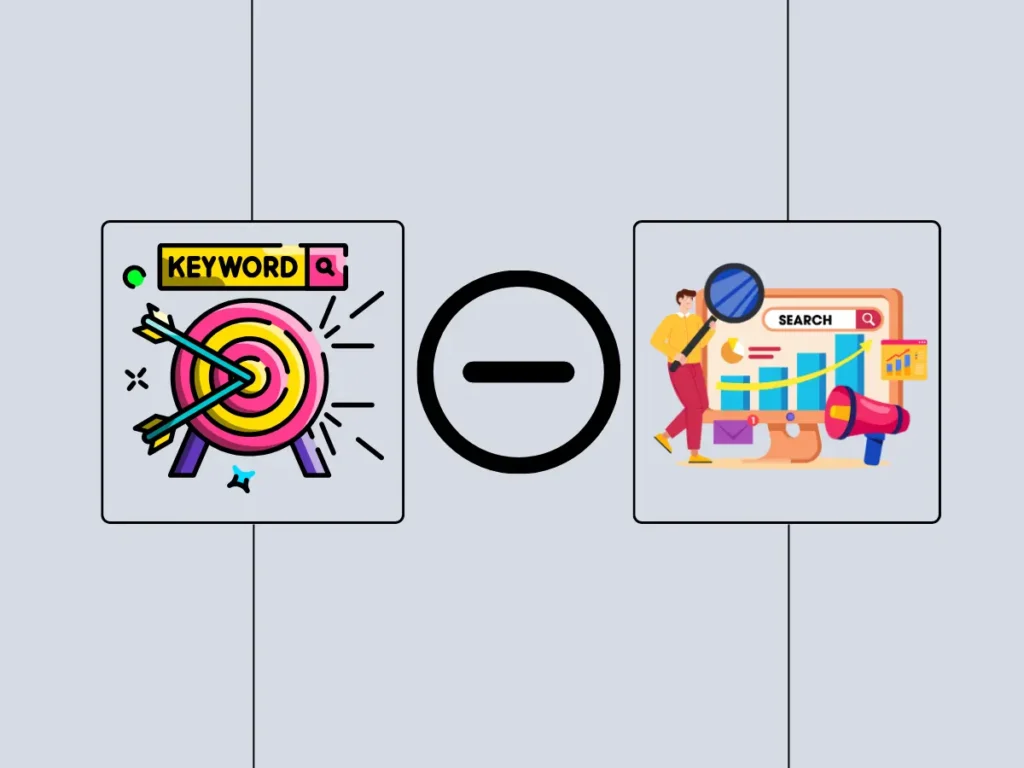
If you’ve ever run a paid advertising campaign, especially on platforms like Google Ads or Bing, you know how easy it is to burn through your budget without seeing much return. One of the most overlooked (yet powerful) tools to fix this is using negative keywords.
Let’s break it down in simple terms and show you how using negative keywords can drastically improve your campaign efficiency, save money, and drive better results. And while you’re optimizing your ad spend, don’t forget to align your efforts with organic growth too. Explore our strategies to unleash your social media marketing and build a full-funnel approach that drives both traffic and trust.

What are Negative Keywords?
Negative keywords are the words or phrases you don’t want triggering your ads. Think of them as filters that help you avoid showing your ads to people who aren’t the right fit, saving you money and improving your chances of reaching people who are genuinely interested.
Let’s say you’re running ads for “car insurance.” You want your ad to appear for searches like “best car insurance plans,” but definitely not for people searching “cheap car insurance.” That’s where negative keywords come in; you can tell Google to exclude your ads from showing up when certain words (like cheap) are part of the search.
The more specific you are with your negative keywords, the better. Getting laser-focused helps you avoid wasting your ad budget on clicks from people who are unlikely to convert, no matter how many times they see your ad.
The bottom line is that when used correctly, negative keywords make your online advertising smarter, leaner, and more profitable.
Why are Negative Keywords so Important?
Negative keywords might not sound like a big deal, but they can make a huge difference in the success of your paid ads, both in terms of performance and protecting your brand image. Let’s break it down:

1. Smarter Targeting = Better Results
In paid advertising, targeting is everything. Your goal is to get the right message in front of the right person at the right time. But here’s the thing: not everyone searching online is your ideal customer. That’s where negative keywords come in.
They help you avoid showing your ads to people who are unlikely to convert. By filtering out irrelevant or misleading search terms, you can stop wasting money on unqualified clicks and improve your clickthrough and conversion rates.
Think of it like this: instead of casting a wide net and hoping for the best, negative keywords let you tighten your aim, keeping your ads focused and effective.
2. Protecting Your Brand’s Reputation
Now let’s talk about the image. Your brand is more than just a product, it’s a promise. If your ads start showing up next to keywords like “cheap” or “free” (when your product is high-end), it can send the wrong message and damage how people perceive your brand.
Negative keywords give you control over the context in which your ads appear. By blocking unwanted associations, you help ensure your business is seen in the right light, credible, trustworthy, and aligned with your actual offer.
Types of Negative Keywords
When setting up your Google Ads campaigns, understanding how negative keywords work can save you from wasting money on irrelevant clicks. There are three main types of negative keywords you can use: broad match, phrase match, and exact match. Each one filters out searches a little differently.
Let’s break them down using the negative keyword “board games” as our example.
1. Negative Broad Match (Default)
This is the default setting in Google Ads. With a negative broad match, your ad won’t show if a search query includes all the words in your negative keyword, even if they appear in a different order. So, if someone searches for “games board,” your ad won’t appear.
However, if a search includes only part of the term, like “video games” or “game boards,” your ad might still show up, because not all the negative keyword terms were matched.
Example:Search: “kids board games” → Ad blockedSearch: “kids games” → Ad may still show
2. Negative Phrase Match
With this match type, your ad won’t appear if a user’s search includes all the negative keywords in the exact same order, even if there are extra words before or after.
Example: If your negative phrase match is “free shoes,” your ad won’t show for “buy free shoes online,” but might still show for “free running shoes,” since the words aren’t in the same order.
3. Negative Exact Match
This one is stricter. Your ad will only be blocked if the search matches your negative keyword exactly, with no additional words.
Example: If “free shoes” is your negative exact match, your ad won’t appear for “free shoes,” but it could still appear for “buy free shoes” or “free shoes for kids.”
How to Find the Right Negative Keywords
Choosing the right negative keywords isn’t about guessing, it’s about strategy. Here are three simple but effective ways to uncover the terms you don’t want triggering your ads:
1. Check the Search Terms Report
If you’re running ads on platforms like Google Ads, your Search Terms Report is a goldmine. It shows the exact words people searched before clicking your ad.
Scroll through the list and flag any phrases that feel off-target or irrelevant. For example, if you’re selling luxury products and someone found you through “cheap alternatives,” that’s a sign to add “cheap” as a negative keyword.
2. Use Google Autocomplete and Keyword Tools
Start typing your main keyword into Google’s search bar, and take note of the autocomplete suggestions that pop up.
If you see terms like “free,” “used,” “DIY,” or anything else that doesn’t match your offer, those might be perfect negative keywords to add.
You can also use tools like Ubersuggest, Keyword Planner, or SEMrush to find common variations and phrases that aren’t aligned with your goals.
3. Think Like Your Customers (and Non-Customers)

Put yourself in the mindset of someone who’s not your target audience. What kind of words or phrases might they use when searching?
Maybe they’re looking for secondhand items, free trials, or how-to guides. And if that’s not what you offer, filtering out those searches with negative keywords helps focus your ad spend on the right clicks.
Ongoing Maintenance Matters
Adding negative keywords once and walking away won’t cut it. Digital marketing campaigns aren’t static. They change and grow over time, and your keyword strategy needs to keep up.
Think of it as regular upkeep:
- Review your search terms weekly. See what’s working, and what’s not.
- Continuously refine your negative keyword list. Trends shift, and so should your filters.
- Always ask yourself: “Is this the kind of person who’s likely to convert?”
If the answer is no, it might be time to add a new negative keyword and keep your traffic clean and relevant.
Frequently Asked Questions
Final Thoughts
You don’t need to double your ad budget to double your results. Sometimes, all it takes is better targeting. And that’s where using negative keywords comes in.
By telling ad platforms what not to show, you gain more control, spend less on wasted clicks, and boost your campaign efficiency in a way that really moves the needle.
So, the next time your ad performance isn’t quite hitting the mark, ask yourself: “Am I using negative keywords wisely?” The answer might be the simple fix you’ve been looking for.
If you’re unsure where to start or want expert help refining your campaigns, book a free discovery call with us. Let’s make your ads work smarter, not harder.




